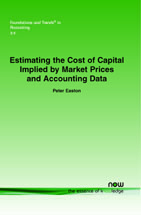Estimating the Cost of Capital Implied by Market Prices and Accounting Data
By Peter Easton, Center for Accounting Research and Education, The University of Notre Dame, peaston@nd.edu
Abstract
Estimating the Cost of Capital Implied by Market Prices and Accounting Data focuses on estimating the expected rate of return implied by market prices, summary accounting numbers, and forecasts of earnings and dividends. Estimates of the expected rate of return, often used as proxies for the cost of capital, are obtained by inverting accounting-based valuation models. The author describes accountingbased valuation models and discusses how these models have been used, and how they may be used, to obtain estimates of the cost of capital.
Estimating the Cost of Capital Implied by Market Prices and Accounting Data
Estimating the Cost of Capital Implied by Market Prices and Accounting Data focuses on estimating the expected rate of return implied by market prices, summary accounting numbers, and forecasts of earnings and dividends. Estimates of the expected rate of return, often used as proxies for the cost of capital, are obtained by inverting accounting-based valuation models. The author describes accounting-based valuation models and discusses how these models have been used, and how they may be used, to obtain estimates of the cost of capital. The practical appeal of accounting-based valuation models is that they focus on the two variables that are commonly at the heart of valuations carried out by equity analysts – forecasts of earnings and forecasts of earnings growth.
The question at the core of this monograph is: How can these forecasts be used to obtain an estimate of the cost of capital? The author examines the empirical validity of the estimates based on these forecasts and explores ways to improve these estimates. In addition, this monograph details a method for isolating the effect of any factor of interest (such as cross-listing, fraud, disclosure quality, taxes, analyst following, accounting standards, etc.) on the cost of capital. If you are interested in understanding the academic literature on accounting-based estimates of expected rate of return this monograph is for you.
Estimating the Cost of Capital Implied by Market Prices and Accounting Data provides a foundation for a deeper comprehension of this literature and will give a jump start to those who have an interest in these topics. The key ideas are introduced via examples based on actual forecasts, accounting information, and market prices for listed firms, and the numerical examples are based on sound algebraic relations.
